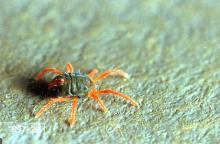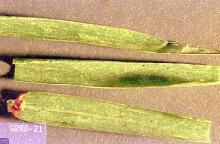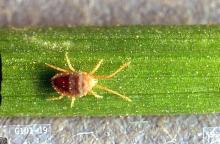Clover mite (Bryobia praetiosa)
Winter grain mite (Penthaleus major)
Pest description and crop damage Clover mites are light brown while winter grain mite is blue with red legs. These cool-season mites have been causing serious damage in central Oregon pastures since 1999. Mite populations begin building in October, and the most damage to grass pastures is from late February through May. Affected grass pastures fail to green up in the spring, and large mite populations have been known to kill orchardgrass pastures.
Management-chemical control
Effective insecticides that control clover mite have not been identified. The two synthetic pyrethroids listed below, while not labeled specifically for winter grain mite control, have been shown to be effective in Oregon research when used at mid-range label rates for other pests. These insecticides are recommended for use in Washington and Oregon only.
- beta-cyfluthrin (Baythroid XL) at 0.013 to 0.015 lb ai/A. PHI 0 days for grazing or hay. REI 12 hr. Do not exceed 0.089 lb ai/A per season Retreatment interval 5 days.
- lambda-cyhalothrin (Warrior II) at 0.02 to 0.03 lb ai/A. PHI 0 days for grazing and forage; 7 days to be dried for hay. REI 24 hr. Do not exceed 0.03 lb ai/A per cutting or 0.09 lb ai/A per season. Minimum re-treatment window is 30 days. For suppression only.
Management-biological control
- Neoseiulus californicus, a predatory mite, has shown effectiveness in managing mite populations in various crops, including pasture systems, by reducing overwintering populations
Management-cultural control
- Tillage to reduce the residue and overwintering habitat
- Crop rotation with nonhost crops for example not planting small grains, and pastures/ grass hay more than two years in succession




